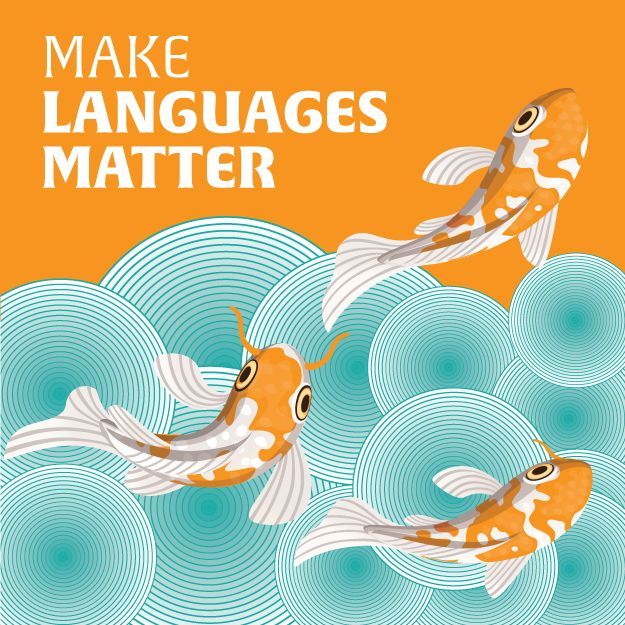Case Study 2
CLIL in the high school – A Languages teacher ‘going it alone’
Owner of Languages Roadshow, Kelly Harrison, never expected that a single cherry blossom collage lesson would change the trajectory of her teaching career.
Up until that lesson, she had been teaching Japanese basically the same way she had been taught – her classes were based on a communicative model, and imparting the joy and intricacies of Japanese culture were front and centre, but most of the interaction with students was in English.
This wasn’t just because she was replicating what she had experienced as a student, but also because as an early career teacher she was worried that she wouldn’t be able to form meaningful relationships with her students if she spoke to them predominantly in Japanese.
Just as her teaching methods were mirroring her experiences as a learner, Kelly also found the struggles she faced as a learner were being mirrored in her students. Kelly was a top-notch rote learner at school and got excellent marks for Year 12 Japanese. However, when she started at UQ in her Japanese major, she realised she couldn’t hold a conversation to save herself.
A year on exchange in Kitakyushu eventually sorted that out, but she felt very strongly that she didn’t want her Year 12s to graduate and have that same experience of feeling completely deficient as a speaker of the language. She wanted better for them, and was shopping around for ways to break that cycle.
Back in 2015, Kelly was encouraged by her Japanese-teaching principal, Dr Margaret Lee, to try Content and Language Integrated Learning (CLIL). Having not heard of CLIL, Kelly did some research and felt very alarmed. She felt there was no way she could manage to teach another subject area in Japanese, and as embarrassed as she is to admit it now, she wasn’t convinced her students could handle it.
The research was there, though: CLIL worked, and it worked across diverse settings with a diverse range of students. Kelly set about trying to test this for herself and started with a single lesson – a craft activity for Year 7 on their first day.
The feedback from that lesson transformed Kelly’s career. Students who had been completely disengaged with Languages at primary school commented that they hoped all Japanese lessons would be like this at high school. Students remarked on the sense of accomplishment and pride they felt at being able to successfully participate in a lesson that was delivered entirely in a language that was, until that point, completely unfamiliar.
Kelly could see the immense potential for engaging students in those compulsory years and could picture CLIL as a solution for keeping students engaged who’d already done a few years of primary school Japanese but got sent back to ‘the start’ when they entered high school.
She then undertook a variety of other trials, including an after-school cultural program with native-speaking guest teachers, and a three week Year 8 Japanese history unit. Her biggest learning from the Year 8 History unit was that students who had traditionally struggled with Japanese (some of whom had diagnosed speech and language difficulties) felt better supported in the CLIL setting than they did in the ‘standard’ Languages setting. She also found that with every trial she undertook, she was more excited by the possibilities of CLIL.
During this trial and research phase, Kelly was given some good advice. Whilst these after school activities and short units were fun, she needed to develop a year-long ‘real’ subject – something that either filled a gap in the school’s offerings or something that the school community would value.
Kelly settled on developing a year-long Japanese Media Studies course, for Year 9/10. She chose this because the Media Arts curriculum played to her skills and interests as a high school English teacher, and secondly because the school she was at didn’t have any ‘film and tv’ style offerings. Also, Japanese media (tv, commercials, anime etc) is a treasure trove of fascinating content that she knew her students would find engaging.
And so the planning began.
It was a massive, humongous, overwhelming process. Kelly was working completely alone, with no mentor and no access to any suitable Australian Curriculum-aligned resources. Everything had to be created from scratch and she had to seek advice from more experienced CLIL teachers, who were generally interstate.
The huge time investment required to get this program off the ground was only made possible because Kelly had secured a $20,000 grant (through Brisbane Catholic Education but funded by the Commonwealth Government) to work on the program. Apart from a few books and a trip to a conference, most of those funds were spent on teacher release time that allowed Kelly to plan.
This is the great challenge of getting a well-resourced CLIL program off the ground: You need time. You don’t need amazing technology. You don’t need to have native speaking proficiency. You do need time. And time is money.
If Kelly could have had one thing to help her during that time, she would have chosen access to CLIL resources that were Australian Curriculum aligned and already translated into Japanese. So many of the CLIL resources available online are written for the European market and are generally for teachers of English as an additional language. There is little to nothing available for CLIL teachers in Australia. And this is a problem, because there is so much untapped potential within this pedagogical approach.
Was that time investment worth it? Yes, yes, and yes again. 100% of the kids in that first Year 10 CLIL class continued into senior Japanese. They were undoubtedly the most proficient Year 11 students any of the teaching staff at that school had encountered. That class formed meaningful, long-lasting bonds with each other, as they all struggled, laughed and built new brain pathways together.
Kelly was already pretty excitable about her job, but this experience took it to a new level. She felt compelled to help other teachers on their CLIL journey, so she started speaking at conferences. Then, after having her first baby, she started Languages Roadshow so she could dedicate herself full-time to being the CLIL mentor she wished she’d had!
Languages Roadshow is working on resources to support teachers who are keen to experiment with CLIL but don’t have the time to create an entire program from scratch. Make sure you are on our mailing list to stay up to date.


